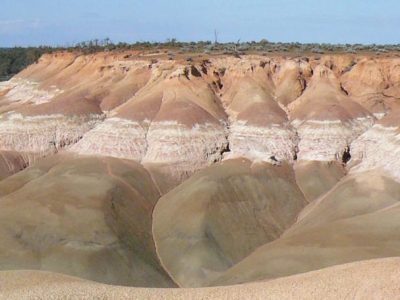Neogene and Coasts

How Australia dried out and how our beaches were formed (photo source: australasianscience.com.au)
I have been reading this week some literature on the Neogene Period and coastal morphology. Why you may ask? Well for many years this geological period has underpinned much of what I have been thinking and writing about and in the course of this work have been fascinated by contrasting evolution of coastal regions over a longer time period than we mostly think about.
First, let us define the Neogene. It is generally accepted (but not universally) that this period started around 23 million years ago and ended around 2.5 million years ago when we entered the Quaternary Period. It can be divided into two epochs: Miocene and Pliocene. It is an exciting part of geologic history (what part isn’t?) as we see continents more or less in their present positions, biota evolving into modern forms, and hominids appearing in Africa. From a climate perspective we see the Earth cooling, large areas drying, glacial systems growing and thus sea levels falling.
I first encountered the Neogene in drilling holes in the Outer Coastal Plain of South Carolina in the 1960s. I spent two fascinating summers with a team from the South Carolina Geological Survey. Quite frequently we encountered the fossil rich Duplin Formation as ‘’basement’’ in our drilling of Quaternary sediments. The Duplin is late Miocene to Pliocene in age. It represents a stand of the sea that stretches up to 100 km inland reaching 60-70 m high then dipping below sea level at the coast. Various sedimentary facies are represented. What is important is that it abuts on the landward side the Orangeburg Scarp, a feature that is interpreted along the coastal plain as a Neogene shoreline cut into older rocks of the Middle Coastal Plain. My work aimed to unravel the morphostratigraphy of materials that overlay the Neogene sediments. This involved mapping a series of sand barriers, backbarriers and fluvial surfaces of various ages noting that the barriers occur at successively lower elevations towards the coast. It should be noted that along the Atlantic Coastal Plain the elevation of these surfaces of a given age varies including the Orangeburg Scarp; they generally rise northwards indicating a degree of tectonic deformation.
Around sections of the Australian coast, especially the south and the southwest, a similar “staircase” sequence of shoreline deposits occurs stretching back into the Neogene; a good example is the calcarenite sequence in the lower Murray-Darling Basin. However, things are different along the east coast north from Gippsland Basin. The highest marine shoreline deposits are of late Quaternary age reaching no more than around 5-10m elevation. Marine Neogene materials are not obvious above sea level. But seismic surveys on the continental shelf revealed a thick wedge on the edge of the shelf thinning landwards. In fact those surveys revealed off central NSW a very thin cover of sediment overlying a rocks Mesozoic age or even older. A few years ago Peter Cowell and I were pondering the origin of our cliffs. Alberto Albani had previously detected filled river valleys cut into the relatively smooth rock surface leading into the sediment wedge of the shelf edge. Jock Keene kindly showed us a set of seismic sections that confirmed this work and together we published our findings. Is this where the Neogene fits in?
We hypothesised that the eastern continental margin was subsiding since the Tasman Sea rifting ceased around 50 million years ago. Rivers draining the higher lands to the west were initially graded to sea levels on the shelf edge. As subsidence continued in the Neogene, the valleys were infilled and the wedge of sediment on the shelf edge continued to grow while to landwards a marine planation surface was cut as the cliffs were rolled back. Sea levels progressively got higher and higher reaching their present levels late in the Quaternary during high stands of glacial/interglacial cycles. So the Neogene sediments are not onshore but offshore along this coast.
The contrasting experience for me of working in these two coastal regions has been quite profound. It has highlighted two concepts: one the importance of relative sea levels in the interpretation of coastal history; and two that continental margins can be “emerged’’ while others can be “submerged”. Douglas Johnson back in 1919 made this distinction but for different reasons. Subsiding continental margins such as those of eastern Australian leave their own imprint on coastal landforms with cliffs, drowned valleys and lakes within sandy embayments. Emerged coasts show other features that are less dramatic but nonetheless beautiful and intriguing.
– words by Prof. Bruce Thom


